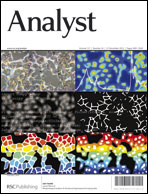Investigation of the catalytic activity and stability of enzymes in confined nano/microspace provides valuable contributions to the fundamental understanding of biological reactions taking place on a mesoscopic scale within confined spaces. In this paper, macroporous silica foam (MSF) is used as a nanoreactor to co-confine glucose oxidase (GOD) and horseradish peroxidase (HRP). Then, the enzymatic cascade reactions, which act in tandem inside nanoreactors, for oxidation of glucose and 3,3′,5,5′-tetramethylbenzidine (TMB) were studied. The catalytic kinetic parameters of apparent Michaelis constant (Kappm) and maximum rate (Vmax) were obtained from Lineweaver–Burk plot by UV-vis spectrometry. Results showed that the catalytic activity of the co-confined enzymes is reduced compared to that of free enzymes in solution at room temperature. The stabilities of co-confined enzymes in denaturing agents, such as guanidinium chloride (GdmCl) and urea, were higher than those of free enzymes in solution. When employing a co-confined bienzyme system as a biosensor for the detection of glucose, a wider linear range of glucose was obtained for the co-confined bienzyme system than for free enzymes in solution.

You have access to this article
 Please wait while we load your content...
Something went wrong. Try again?
Please wait while we load your content...
Something went wrong. Try again?


 Please wait while we load your content...
Please wait while we load your content...